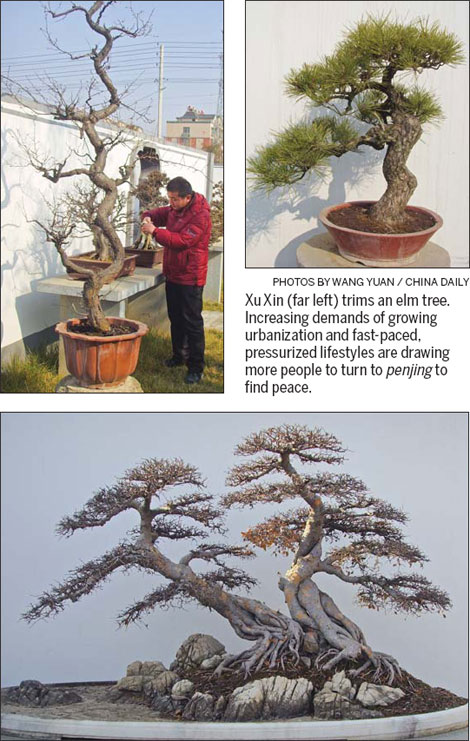Peace in a pot
Updated: 2012-04-13 07:43
By Wang Yuan (China Daily)
|
|||||||||||


Chinese art of cultivation takes root in modern times
Faced regularly with the cut-throat and high-stress workings of business negotiations, Xu Xin has cultivated more than 4,000 "friends" in the past two decades to help him deal with all that pressure.
But Xu's "friends" are not a local or global network of support groups. The "friends" that help Xu, 50, a businessman, find peace sit in pots as miniature versions of plants, rocks, trees and landscape. These are penjing, the ancient Chinese art of growing tray plants.
"When you foster penjing, you should concentrate all your attention to prune them, achieving a degree of focus and singularity similar to Buddhist Zen mentality," says Xu, who has a garden containing all his beloved plants.
"Bad-tempered people can find peace in penjing," Xu says. "You need to spend 10 to 20 years to rear a mature penjing work, to really cultivate your mind. Those who raise penjing won't lose their temper easily and usually have a longer life than others."
Rui Xinhua is a renowned master of penjing, similar to the commonly known bonsai, in East China's Nanjing and has been involved with the art for more than 30 years.
"You need to spend time and take care of them every day - pruning, watering, designing their shapes. As we often say, penjing is like our own children," Rui says.
"Penjing is more than just simple gardening; you need to learn about the local climate, soil, fertilizer, their ailments and how to really nurture them."
Many penjing lovers say the increasing demands of growing urbanization and fast-paced, pressurized lifestyles are drawing more people in the cities to turn to the ancient Chinese art to find peace.
"For those who are frustrated in these times, the art helps to bring joy and comfort. Many penjing growers regard the plants as a process of cultivating their inner wellbeing," says Costa Wang, editor of the Chinese magazine Penjing, which introduces penjing masters and their works.
The art of penjing originated during the Tang Dynasty (AD 618-907), with murals about the practice found in the royal tomb of Tang Princess Zhanghua in Shanxi province.
Poems on penjing are also found in works of renowned poets like Su Shi and Lu You of the Song Dynasty (AD 960-1279).
Penjing art later experienced high points during the Ming and Qing dynasties, as it spread to other Asian cultures including those on the Korean Peninsula as well as in Vietnam and Japan.
Chinese penjing has eight schools divided by their growing areas, including Anhui, Jiangsu, Zhejiang, Sichuan and Guangdong provinces. Most penjing are grown in East and South China, where the climate is suitably mild and wet.
The principles in growing penjing are similar to those in traditional Chinese painting, which take its inspiration from the beauty of nature. A classical penjing work needs to achieve a natural balance between man-made design and the natural landscape of the plants.
"A good penjing work needs to show that the plants are growing naturally, leaving no traces of human intervention," Rui says. "We also create penjing based on natural scenery, like pines growing on mountains, plum blossoms in spring and fruits in autumn."
"To produce a good penjing, you need to understand the plants, to let them grow into shapes that reflect an understanding of nature," Costa Wang says.
Rui says penjing helps him "mould" his character - he learned martial arts when he was young and was always short-tempered as a negative result of that, but taking up penjing changed his temperament and helped improve his health.
"Penjing needs a relatively peaceful environment to flourish," Rui says, adding that the art declined in China during the early stages of the last century amid wars and upheavals. But in neighboring Japan it continued to develop as bonsai.
Penjing is now experiencing a resurgence, with an increasing number of common households and ordinary people appreciating it, Rui says.
"We are expecting more people to join the penjing community. There are now about 1,000 penjing associations in China and we hold several hundred exhibitions every year when experts and masters gather and communicate with each other," Rui says. Members come from all walks of life to share their love for creating penjing, he says.
"We hope penjing can enter more common homes so that ... these traditional arts of China can continue to grow and flourish."
Contact the writer at wangyuan@chinadaily.com.cn
Today's Top News
Rescuers race against time for quake victims
Telecom workers restore links
Coal mine blast kills 18 in Jilin
Intl scholarship puts China on the map
More bird flu patients discharged
Gold loses sheen, but still a safe bet
US 'turns blind eye to human rights'
Telecom workers restore links
Hot Topics
Lunar probe , China growth forecasts, Emission rules get tougher, China seen through 'colored lens', International board,
Editor's Picks

|

|

|

|

|

|





